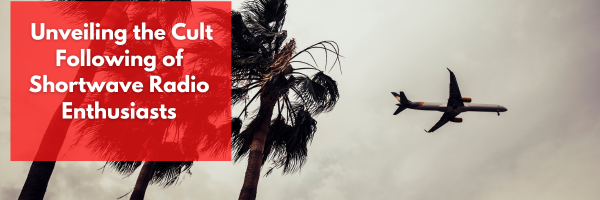
In a world dominated by modern technology and instant communication, there exists a unique and passionate community of shortwave radio enthusiasts who find their thrill in tuning into aviation broadcasts. While it might seem like an esoteric hobby, listening to aviation broadcasts over shortwave radio has cultivated a cult following
Here are some of the reasons so many listeners follow the HF aircraft band.
Kind of like a global adventure!
Shortwave radio allows enthusiasts to embark on a global adventure from the comfort of their homes. Aviation broadcasts provide a portal into the skies, enabling listeners to eavesdrop on conversations between pilots and air traffic controllers from all corners of the world.
The sense of adventure and the opportunity to virtually traverse continents is a compelling reason why shortwave radio enthusiasts are drawn to aviation broadcasts
Shortwave radio provides real-time access to aviation communications. Enthusiasts can listen in on air traffic control exchanges, weather information, flight paths, and even emergency communications as they happen.
It is quite technical!!
Fine-tuning shortwave radios and antennas to receive clear aviation signals is a technical challenge that appeals to hobbyists. It requires skill and patience to optimise reception and achieve the best audio quality.
The technical aspect of the hobby fosters a sense of accomplishment and expertise, further deepening the enthusiast’s connection to shortwave radio.
Amateurs listening in during an emergency have saved the day in the past, both in the air and by sea!!
Shortwave radio is a reliable means of communication during emergencies. Aviation enthusiasts play a vital role in monitoring aviation frequencies during critical situations, potentially assisting authorities or providing essential information.
This sense of responsibility adds a noble dimension to the hobby, reinforcing the dedication of shortwave radio enthusiasts.
There is quite a community too!!
While shortwave radio listening can be a solitary activity, it also nurtures a strong sense of community. Enthusiasts connect through online forums, clubs, and social media groups, where they share their experiences, knowledge, and tips.
The sense of camaraderie among like-minded individuals contributes significantly to the cult following of this hobby.
For some, listening to aviation broadcasts on shortwave radio is a tradition passed down through generations. The nostalgic element, combined with the heritage of the hobby, creates a sense of continuity and connection to the past.
Listening to aviation broadcasts over shortwave radio may seem like a niche hobby, but it offers a world of adventure, technical challenges, and a close-knit community that has earned it a dedicated cult following.
Vast areas of the world lack the necessary local VHF radio communication systems needed to provide reliable radio coverage between aircrews and air traffic controllers. The lack of VHF coverage within most of these areas is due to the very remote location of these regions, for example, much of the airspace over the Atlantic and Pacific oceans lacks VHF communications as it is impossible to install transmitters on a reliable platform within these regions. As a result, a network of shortwave (HF) frequencies have been allocated to provide long range voice communications between aircrews and ATC facilities.
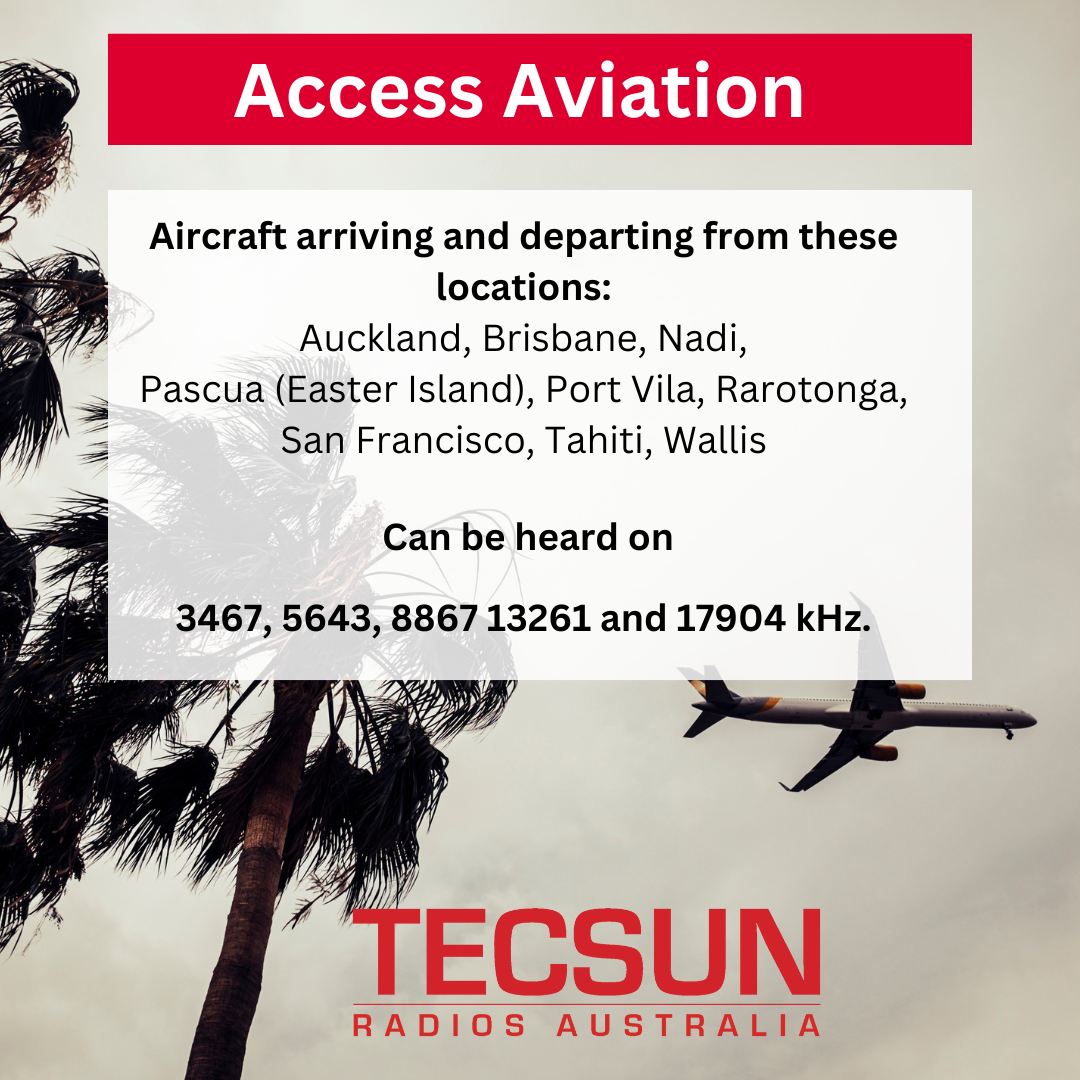 The allure lies in the ability to bridge the gap between the terrestrial and the celestial, allowing enthusiasts to soar through the skies without ever leaving their homes. So, whether you’re a seasoned shortwave radio enthusiast or a curious newcomer, consider giving aviation broadcasts a try – you might just find yourself captivated by the mesmerising world of shortwave radio and its passionate following.
The allure lies in the ability to bridge the gap between the terrestrial and the celestial, allowing enthusiasts to soar through the skies without ever leaving their homes. So, whether you’re a seasoned shortwave radio enthusiast or a curious newcomer, consider giving aviation broadcasts a try – you might just find yourself captivated by the mesmerising world of shortwave radio and its passionate following.
Here at Tecsun Radios Australia we have the best range of radios to support your shortwave listening adventures, we even supply a comprehensive shortwave listening guide, written by owner and fellow enthusiast, Garry himself!!!
Curious about listening to Aviation broadcasts, here are some of our top radios for the job.
PL-880, PL-990x, H-501x, PL-330, PL-365, PL-368, PL-660, S-2000. Most receivers in the Tecsun Radios Australia range have the ability to receive single sideband (SSB) transmissions, and that is the mode used by aircraft on the HF bands. As you can see, even the most economical receiver (PL-365) is capable of listening to aircraft on the HF bands.
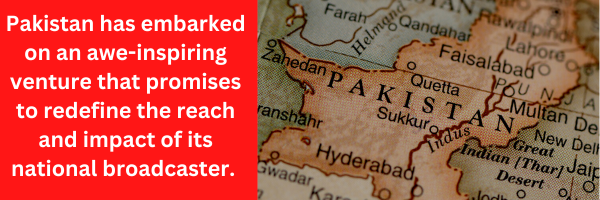
In a momentous stride toward enhancing its broadcasting capabilities, on July 30, 2023, Radio Pakistan embarked on the groundbreaking ceremony for an expansive transmission facility, poised to connect the diverse tapestry of nations spanning from the Mediterranean to the Pacific.
The heart of this transformative endeavor revolves around the installation of a cutting-edge 1,000 kW Digital Radio Mondiale (DRM) transmitter at the eminent Radio Pakistan high-power transmission complex, strategically situated near the capital city of Islamabad. This monumental project comes with a price tag of approximately 4 billion rupees (nearly US$14 million) and is slated for completion by the year 2025.
Central to this project’s significance is its alignment with the Digital Radio Mondiale standard, which is a monumental leap into the digital age for Radio Pakistan. This groundbreaking move underscores Radio Pakistan’s commitment to modernization, leveraging state-of-the-art technology to usher in a new era of broadcasting excellence.
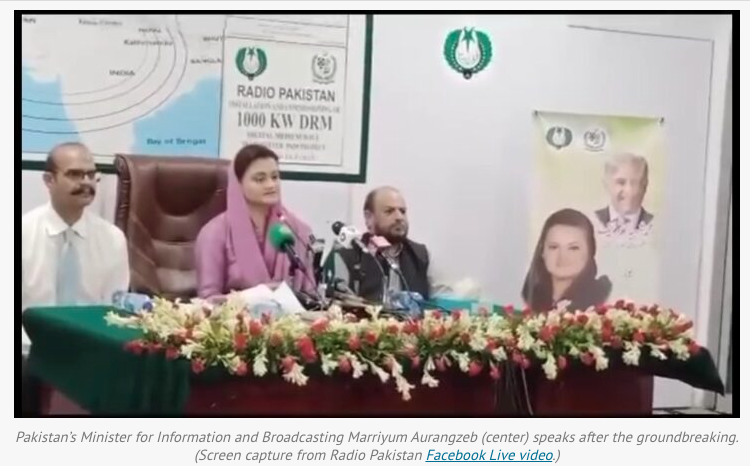
Image via https://www.radioworld.com/
Guiding this landmark occasion was the honorable Federal Minister for Information and Broadcasting, Marriyum Aurangzeb. Aurangzeb highlighted the pivotal role that this initiative would play in expanding Radio Pakistan’s reach, resonating across 52 nations spanning South Asia, Central Asia, the Far East, Middle East, and even Eastern Europe.
Quoting her words:
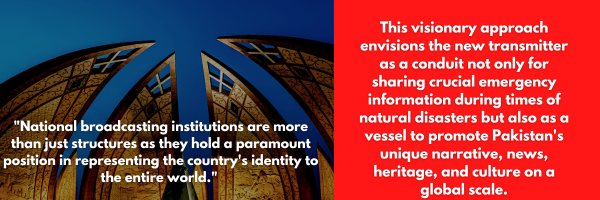
It’s worth noting that Radio Pakistan, since its inception in 1947, has primarily relied on analog medium, and shortwave transmitters. However, this transformational project acknowledges the changing tides of technology. Out of its current inventory of 20 transmitters, 14 have outlived their utility. This forward-thinking initiative is set to redefine broadcasting norms by empowering Radio Pakistan to transmit up to four distinct signals concurrently with remarkable efficiency. Moreover, the energy-efficient design of the 1,000 kW DRM transmitter is expected to reduce energy consumption by an impressive 33%, subsequently leading to substantial savings in operating costs.
Beyond the transmitter’s exceptional capabilities, Marriyum Aurangzeb revealed another ambitious plan that aligns seamlessly with the government’s vision. A new media city is poised to take shape in Rawat, complementing Prime Minister Shehbaz Sharif’s visionary commitment to bolstering investment in information technology and media technologies. This holistic approach aims not only to cultivate enhanced employment opportunities but also to actively engage the youth with the captivating world of radio.
As the groundbreaking ceremony set the wheels in motion for this transformative endeavor, Pakistan takes a bold step toward shaping the future of broadcasting. With the fusion of tradition and modernity, the country’s rich tapestry of culture, identity, and communication is set to resonate across borders, reaffirming the enduring power of the airwaves to unite, inform, and inspire.
This article was reproduced by Tecsun Radios Australia from the original article posted on https://www.radioworld.com/
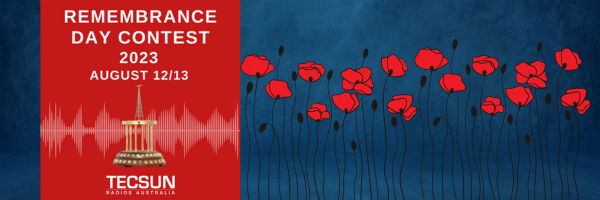
In a world marked by technology and connectivity, it’s vital to remember the sacrifices made by those who came before us. The upcoming Remembrance Day Radio Contest, scheduled for the weekend of August 12 and 13, 2023, is a poignant opportunity to pay homage to the amateur radio operators who valiantly gave their lives during both World Wars.
Held annually, this contest stands as a testament to their memory and the enduring spirit of camaraderie that amateur radio embodies.
Date and Time: Starting from 0300 UTC on Saturday and ending at 0300 UTC on Sunday, this two-day event promises to be an engaging and meaningful experience for amateur radio enthusiasts across the globe. As the world turns, the contest provides participants with the chance to connect with fellow amateurs, share stories, and remember the past.
Aim of the Contest: The heart of the Remembrance Day Radio Contest lies in its purpose – to establish connections and build bridges through the airwaves. During the event, amateurs strive to contact fellow amateurs in VK call areas, ZL, and P2. All bands except the WARC bands are open for communication, and participants can use the modes of PHONE, CW, and RTTY – modes that echo the communication methods of both World Wars.
Honouring History: The perpetual trophy is bestowed upon the state or territory that exhibits the best performance. More than just a symbol, this trophy serves as a reminder that the essence of the contest is not only in the competition but in the act of remembering and honoring those who came before us.
A Weekend of Exploration: For those who may not be amateur radio operators themselves, the contest presents an excellent opportunity for shortwave listeners to engage. It’s a time to put antennas, receivers, and reception techniques to the test. As the contest unfolds, the airwaves will buzz with activity, creating an environment of curiosity and excitement for those who wish to participate from a different angle.
Contest Rules
3. Contest Date & Time
Weekend in August closest to the 15th, 0300 UTC Saturday to 0300 UTC Sunday.
As a mark of respect, stations are asked to observe 15 minutes silence prior to the start of the contest, during which the opening ceremony will be broadcast.
4. Categories
1. Single Operator
2. Single Operator – QRP
3. Multi-Operator – Single Transmitter (Multi-Single)
4. Multi-Operator – Unlimited (Multi-Multi)
5. Sub-Category Modes for Single Operators
1. Phone (AM, FM & SSB)
2. CW (CW & RTTY)
3. Mixed
6. Permitted Bands
1. Contacts may be made on MF (160M), HF and VHF & above bands except for WARC bands (10, 18 & 24MHZ) which are excluded by IARU agreement from all contest operations.
a. HF SSB Voice transmissions should be within:
1843-1875, 3535-3570 and 3600-3700, 7080-7300, 14112-14300, 21150-21450, 28300-29100KHz,
otherwise disqualification or points reduction may result.
7. Multi-operator Stations
1. Multi-operator single transmitter stations
a. Are only allowed one transmitted signal on air at any time.
2. Multi-operator Unlimited stations
a. Are only allowed two transmitted signals on any band, one per Phone and one per CW as per rule 5.1 and 5.2.
b. Simultaneous transmissions on different bands are permitted.
3. Multi-operator stations are mixed mode only.
Multi Stations, please observe any COVID Restrictions for your area.
8. Teams
Team scenario 1.
A station and two of their friends operate in the contest from their respective home QTH and participate in the contest and submit their logs in the normal manner. They are eligible for any awards in the category they entered as single operators. The contest manager was notified that these 3 stations want to form a team. Their scores are tallied together and that is the team score.
Team scenario 2.
A multi-single club has 2 operators who wish to work from their home QTH. The 2 single operators and the multi-single club contest and submit logs in the normal manner. They are eligible for any awards in the category they entered. The contest manager was notified that these 3 stations want to form a team. The 2 single operators and the club multi-single stations scores are tallied together and that is the team score.
1. A team can consist of only one of the following two options.
a) Three single operator stations
b) Two single operator stations and one multi-single station
2. A team can consist of stations located anywhere in VK, ZL, or P2.
3. An operator can only be included in one team.
4. Clubs may enter multiple teams of 3 call-signs.
5. The ‘Team Leader’ MUST nominate his team to the Contest Manager before the start of the contest. Email to vk4sn@wia.org.au with the subject “RD Team Submission”.
a) Nominations must include the Callsigns and Operators Name. Where multiple teams from one club are submitted, it is suggested to use Team Names, example: Tazzie Devils
b) The Team leader must supply postal details for receipt of any awards.
c) Once the contest has started, team members cannot be changed.
6. The winner of the team initiative will be the highest combined score from any one team.
7. Team scores are not included in the determination of the winning state.
9. Contacts
1. Suggested Call: “CQ RD”, “CQ Contest”, or “CQ Test”
2. Exchange: A valid exchange consists of RS(T) followed by a number as follows:
a. For a single operator, the number of years you have been a licenced Ham. For example, if this is your 1st year as a ham then you will sign RS(T) 001. Round off to the nearest whole number. All zeros are not accepted.
b. For a multi-op or club station, the number of licenced years of the longest licenced Amateur present at the start of the contest.
3. On all bands, stations may be contacted at intervals of not less than THREE hours since the previous contact on that band and mode.
a. FM & SSB count as one mode, as does CW & RTTY count for the CW mode. Therefore one cannot QSO with a station in FM and work them on SSB on the same band before the three hours is up.
4. No cross band contacts are allowed.
5. Exchange of contact information via satellites, telephones, repeaters, Echolink, IRLP, or the internet is not in the spirit of the contest and is banned.
6. Contacts via satellites are not allowed for scoring purposes.
7. Contacts within the same call area are permitted.
11. General Rules
1. W.I.A. General Rules for All Contests apply unless otherwise specified.
2. All operators of single operator stations must perform all operating and logging without assistance.
a. Use of spotting, skimmer, SDR and similar operator assistance software is allowed on all bands, however all replies, exchanges and log entries must be performed by the operator.
3. Holders of more than one licence or callsign MUST use only ONE callsign for the contest duration.
4. Fully automated operation is not permitted; however, computers can be used for logging or CW or RTTY reception and/or keying.
5. All operations must be in accordance with the band plan for the band in use, as published in the latest LCD.
6. Any station observed as departing from the generally accepted codes of operating ethics or licence conditions may be disqualified.
* QRP stations are limited to 5 Watts average (CW/RTTY) or PEP (SSB) at the transmitter output.
7. REMOTE STATION OPERATION is allowed with the following conditions: (NEW in 2021)
a. Both receiving and transmitting antennas must be co-located and be in Australia.
b. If your remote station is interstate, you must sign VKn??/VKn or VKn/VKn??
c. Points will be allocated to the state you are transmitting and receiving from.
d. The remote site location must be shown by a maiden head six figure grid square in your soapbox comments.
e. All calls and exchanges must be obtained through the TX/RX remote site.
f. Only the remote site can be used during the contest. I.E. Using your personal physical local location for use of local TX/RX operations is not allowed.
12. WW2 ex Military equipment
1. Operators using Ex WW2 equipment will be awarded with a special certificate acknowledging their participation and use of such.
2. A declaration with the heading of WW2 Equipment will operate said units within the “ORIGINAL manufactures specified operating conditions”, e.g. no mods to boost the output power etc. A copy of the preferred Certificate is available on the on the WIA website at http://www.wia.org.au/members/contests/rdcontest/documents/WWII%20Declaration%202012.pdf
3. Please include the declaration with your log submission.
Contest Scoring
10. Scoring
1. On 160 metres two points per completed valid contact.
2. On 23cm or higher bands two points per completed valid contact.
3. On all other bands one point. (no WARC bands allowed)
4. On CW and RTTY, irrespective of band, double points.
5. All QSO’s logged between 0100 and 0600 LOCAL TIME score triple points.
Submitting Your Log
13. Log Submission
1. Electronic Logging
a. Use of logging software is preferred as the output file will be in Cabrillo 3 format which suits our log checking software. See below for logger links.
b. Submit Log WITHIN 14 DAYS by 0300z via https://www.vklogchecker.com/
Please add EMAIL: youremail@myisp to the log header.
c. Or failing b. above, attach your ‘callsign.log’ file to your email and send to rdlogs@wia.org.au
d. Put ONLY your callsign in the subject .
e. On receipt of your log, the manager will send an acknowledgement email to you. Just to be sure, it is advised that you flag your email for “confirmation of receipt”, in which case you will receive two emails acknowledging receipt of the log.
2. Paper Logs
a. Hand written logs are not preferred, however if sent must be legible and contain no more than 100 contacts.
b. Entrants are encouraged to enter the paper logs into a logger after the contest and email the Cabrillo log (callsign.log) as indicated above.
c. Paper logs should be accompanied by a Summary Sheet showing all the details as per the log example below and nominated team name if used.
d. Declaration: I hereby certify that I have operated in accordance with the rules and spirit of the contest; signed & dated. Please supply a contact telephone number.
e. Send paper logs and summary sheets to: RD Contest Manager. 43 Jahn Drive, Glenore Grove, QLD 4342. Do not send logs requiring a signature! Collection is an hours return drive away and may not be collected before results are finished.
3. If you genuinely have problems with the above, then acceptance of .xls, .csv, and .txt files will be considered for processing. PDF, DOC(x), MDB or picture files are not accepted.
4. Emailed Logs are to be received by the contest manager no later than 14 days after the contest ends.
5. Paper logs are to be postmarked no later than 8 days after the contest.
6. All logs will be receipted by email or on the website if no email exists for the operator.
7. Logs received after the closing date will not be eligible for processing.
8. Paper logs will not be returned unless a SASE is forwarded requesting return of the log.
9. VK entrants temporarily operating outside their allocated call area, including those outside continental Australia as defined for DXCC, can elect to have their points credited to their home State by making a statement to that effect on their summary sheet or in the ‘soapbox’ field in the Cabrillo file.
Contest Results
14. Contest Results
1. Determination of Winning State or Territory.
State score = (Total points from logs submitted) divided by (number of licencees in the state or Territory excluding beacons and repeaters). The Number of Licences are supplied to the manager from the WIA National Office for that year.
2. Unless otherwise elected by the entrant concerned, the scores of VK0 stations will be credited to VK7, and the scores of VK9 to the mainland call area which is geographically closest. Scores of P2, or ZL will not be included in these calculations, although entrants in those areas are eligible for all certificate awards.
3. Results will be published within 90 days after the close of the contest on the W.I.A. website and winners announced in AR magazine as soon as practical.
Contest Award
15. Contest Awards
1. Entrants must make at least 25 contacts to be eligible for awards.
2. Overall 1st, 2nd and 3rd place certificates will be posted to recipients.
a. Single Operator Phone
b. Single Operator CW
c. Single Operator Mixed
d. Single Operator QRP Phone
e. Single Operator QRP CW
f. Single Operator QRP Mixed
g. Multi-operator – Single Transmitter
h. Multi-operator – Multi Transmitter
i. Team
j. //DISCONTINUED due to callsigns now not reflecting the licence grade.// The top three foundation scorers regardless of category.
3. Certificates will be awarded to 1st, 2nd, and 3rd place-getters for each VK call area, and ZL & P2 from the WIA office. All other certificates will be via PDF download.
a. Categories “a” through “f” as above.
4. Participants using WW2 ex military equipment will receive a special acknowledgement certificate as well as any certificates gained in winning any section.
Logging Software
17. Logging Software
1. Downloads
a. VK Contest Log (VKCL) by Mike Subocz VK3AVV, https://www.mnds.com.au/vkcl/
b. John Drew VK5DJ RD logging program Link
c. SD Logger by EI5DI. See ei5di.com (HF logging only)
d. N1MM (HF only) Support files (City and UDC) from vk4sn.com/Contests/N1MMVK
2. Remember to check for updates immediately prior to contests to make sure you have the latest software that will contain up to date scoring and rule changes.
Logs are now processed through log checking software that uses Cabrillo V3.0 format.
An example log is as follows:
For further information please click this link through to the Wireless Institute of Australia, from which we sourced our information.


